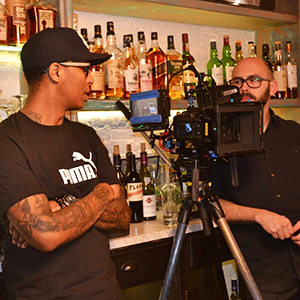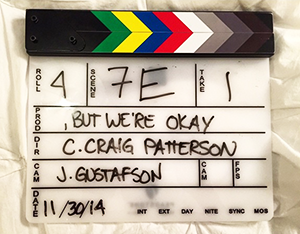Keeping Stories Alive through Film
GS student C. Craig Patterson grew up in New Orleans, Louisiana, immersed in storytelling. The early presence and importance of storytelling in his life eventually led him to his pursuits in filmmaking, both in and outside of the Columbia classroom.

After graduating from high school, Patterson began a career in radio. Shortly thereafter he moved to publishing, becoming the managing editor for Blitz Magazine, where he worked to increase the magazine’s monthly readership.

When Patterson relocated to New York City, he enrolled at GS with the intention of continuing in the direction his life had taken him: the world of publishing and the goal of becoming an editor-in-chief. But his path soon diverged into filmmaking, where he has since flourished. The first screenplay he wrote and directed was LIV, shot on the streets of New York, which along with his second film But We’re Okay was submitted to Sundance and the New York Film Festival in 2015 and will go to Berlinale in 2016. He is currently working on a new feature film called The Wolf, The Sparrow under the moniker Kid with a Kite.
I had the pleasure of talking to Patterson about his journey to GS, current projects and upcoming plans.
You have a background in a variety of media, such as radio and publishing, and now as a screenwriter and director. The common thread that binds these pursuits together is storytelling, which you mention you became aware of as a child in New Orleans. How does this past influence show up in your current work?
Storytelling has played a part in everything I've done since I was young. My experiences of listening to and participating in stories while growing up were so vivid, so permanent that they will always resonate through my work. I was lucky enough to be a kid in my neighborhood in New Orleans at that time, and with those particular family and friends who made my life so colorful and my childhood so memorable. A screenwriter couldn’t have written it better.
Did you have an interest in film before coming to Columbia or was it awakened here?
I was late to the party with filmmaking. My intention when I was accepted to GS was to continue my path in publishing. But on the first day of classes I was making my way up College Walk and saw all of these great buildings spewing out these remarkable people, and I decided then and there that if I could pursue anything I wanted, it would be cinema.
The professors at Columbia have influenced how I perceive filmmaking, whether it is screenwriting, directing or appreciating the overall art form. One of the most significant relationships here has been with Professor Edward Baron Turk, who taught me that craftsmanship dictates whether your film will prove meaningful to generations other than your own.
You worked with military veterans, a vibrant and integral part of the GS community. Can you tell me more about your experience with MilVets?
The military community at Columbia has been incredible to me, even though I have never served myself. Jesse Gustafson, my mentor and the first person to give me an opportunity to direct, is a veteran. My best friend and frequent collaborator, Emil Daubon is a veteran Green Beret medic. My associate producer Eric Nelson, assistant director Tiffani Watts, and my friend/sounding board Mike Gravagno are all military veterans. There aren’t enough amazing words to describe my appreciation for the MilVets here. Any film that I want to pursue would not be possible without United States veterans.
Like others at GS, you arrived after taking a nontraditional path to an academically rigorous school, and have flourished. You received the Tobias Family Scholarship last year and have been a high performing student. How would you describe your academic experience?
It has been rigorous in every sense of the word. As a student of film, who’s aiming to write and direct, assignments can be arduous. I was lucky to have a background in radio and publishing that baptized me in the importance of deadlines (being an older student has also been helpful). My professors at GS believe an education doesn’t just exist within the confines of the classroom. We are pushed to always write, film and approach film in a proactive way.
One of my biggest supporters is the Tobias family. Updating Mr. Tobias on projects I’m working on and getting his direct feedback has been absolutely invaluable. He has become a mentor to me. In 2006, Dito Montiel wrote a memoir called A Guide to Recognizing Your Saints—Mr. Tobias and his wife would certainly be two of mine.

How has your on-campus academic life fed into your off-campus projects, or vice versa?
The two sides have been one in the same. In-class assignments either develop my understanding of the writing process or increase my ability to be more pragmatic in my decision-making as it relates to film. And any projects that I take on outside the classroom, like my first feature-length project The Wolf, The Sparrow, builds my foundation of film as a whole. This in turn prepares me to be a better classmate and student.
Can you talk a little about the feature The Wolf, The Sparrow that you are currently working on?
The Wolf, The Sparrow is a great project, something I fought for and fiercely believed in. The film focuses on the ripple effect from when a lust for vengeance is introduced into a small American town. Kid with a Kite Films is still in pre-production and we are looking to film in summer 2016. We hope it’s a story that disturbs, entertains, and surprises equally!
And finally, what are your plans for after graduation?
After graduation I plan on going to grad school, and of course to continue to recklessly love the art of storytelling. Not necessarily in that order.
